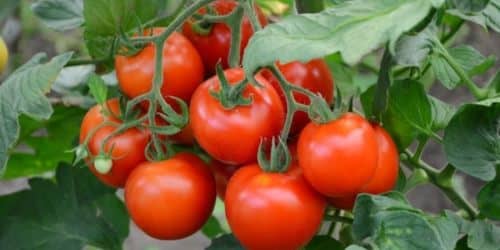In Nigeria, tomato is one of the most significant cooking components. Ninety percent of Nigerian meal is never complete without tomatoes. If you want to understand how to do commercial tomato farming, whether in an open field or in a greenhouse, then read this tomato farming tutorial all the way through.
This how-to-produce tomato guide includes everything from planting tomato seeds to harvesting.
Organic Tomato Farming in Nigeria
Organic farming entails the use of both natural and synthetic chemical inputs for farming. Some tomato farmers prefer organic inputs because they believe organic goods are healthier than chemically farmed meals.
Under organic conditions, manure, microbial inoculum, bio fungicides, bio insecticides, neem oil, and other organic inputs can be employed in commercial tomato farming.
If you wish to perform commercial organic tomato farming, you must ensure that your tomato fruits can be sold at a high price. Organic inputs, particularly biologics and microbials, can be costly.
Types of Tomatoes
There are two different kinds of tomatoes, and they all come with the same price tag. You may have noticed that tomato seed packages are labeled as determinate or indeterminate.
#1. Determinate tomatoes
Determination simply means that the growth and size of an organism are genetically determined to reach a given stage. These tomato cultivars produce ripe, plentiful fruits at a time, but only for a short time. They don’t need to be staked or crated. They work well in containers and in small backyard settings. Also, they are perfect for canning and pasting tomatoes, as well as preparing sauce.
#2. Indeterminate tomatoes
If you don’t stop the growth of these tomatoes, they will grow indefinitely. These are also referred to as “vining” types. They have more leaves, thus their output is more equally distributed throughout the season. Indeterminate tomatoes require staking and are best suited to big gardens.
How to Start Tomato Farming in Nigeria
Growing tomatoes is not difficult; nonetheless, certain conditions must be met in order for the plant to thrive. You must check that the planting period is correct and that you are utilizing the correct variety of tomato seeds.
Following these precautions will ensure success in your commercial tomato farming business, whether it is a greenhouse or an open field, as well as high yields. They are as follows:
#1. Site Selection
Tomatoes prefer fertile farms or soil. The place for tomato cultivation should have sandy loamy soil rich in organic materials.
The property should also have good roads for simple evacuation of harvested produce. Tomatoes can spoil if they are not rapidly moved to a location where they can be used or stored.
Tomatoes may thrive in tropical climates. It can grow in temperatures ranging from 10 to 30 degrees Celsius. When the temperature rises beyond 35 degrees Celsius, flower abortion occurs, as do physiological processes in the tomato plant.
#2. Climatic conditions for tomato farming
Tomato plants thrive in tropical climates. Tomato plants do not thrive in temperate climates. The term “tortoise” refers to a plant that grows in a greenhouse.
Tomatoes do best when grown between 20 and 28 degrees Celsius, while heat-tolerant cultivars such as Platinum F1 can thrive at extremely high temperatures. When it is too hot, tomato plants’ blossoms die; when it is too cold, the fruits do not form.
#3. Finance Requirement
To cultivate tomatoes, you must calculate and assess the estimated cost, income, and profit. A commercial tomato farming business plan must be created, whether for a greenhouse or an open field.
#4. Soil Requirement
The pH of the soil used for commercial tomato farming should be between 5.5 and 6.5. If the soil is overly acidic, limestone or dolomite should be added.
The soil should also be rich in organic matter in order to store water well. High-salinity soil should be avoided.
#5. Land Preparation for Tomato Farming
Nigerian soil types include loamy, clay, and sandy. Tomatoes can grow in any of these soil types; however, some amendments may be required. Tomato plants prefer loamy soil, and clay soil can hold a lot of water, causing root rot.
Because the terrain in Nigeria’s savannah zones (most northern states) is primarily occupied by grasses and short weeds, land preparation for commercial tomato farming is quite simple. A tractor can simply plow and harrow the field, preparing it for planting.
#6. Variety of Tomato to Plant (Tomato Seeds)
Tomato seeds come in a variety of forms. Tomato seeds are classified as hybrid seeds or open-pollinated seeds. Hybrid seeds have been engineered to be resistant to some illnesses and pests, and they often produce more than open-pollinated seeds. Hybrid seeds should not be kept and replanted. Platinum F1, Tylka F1, Cobra F1, Rambo F1, Larisa F1, Chibli F1, and other hybrid tomato seeds can be grown.
Seeds that have been open-pollinated can be kept and transplanted. Roma VF and UC82B are two open-pollinated tomato seeds that can be sown.
#7. Irrigation for Tomato Farming
I am sure you have heard that using irrigation can considerably boost your tomato yield and provide all-year-round cultivation of crops. Which type of irrigation is most suitable for commercial tomato farming in Nigeria?
Many tomato producers in Nigeria still rely on rain to grow their crops. Though it may sound strange, tomato plants do not perform well in the wet season unless you are an expert farmer. Rains increase the likelihood of fungal diseases on tomato plants, and they can also cause flower abortion. In Nigeria, drip irrigation is the best kind of irrigation for commercial tomato farming.
#8. Nursery Management in Tomato Farming
A nursery is essential in tomato farming; nevertheless, some farmers utilize the direct sowing method for tomato cultivation, which is not recommended unless you are very proficient in the act of cultivating tomatoes. Almost all tomato growers I’ve met in Nigeria nursed their tomato plants in nurseries before transplanting them to the field.
Raised beds are used as a tomato nursery by conventional tomato farmers in Nigeria. The raised beds are covered with dried leaves or palm fronds to minimize the intensity of the sunlight. Some farmers use shade nets to shade their nurseries.
For a one-acre tomato nursery, the seed rate should be 300-500 grams of tomato seeds. When creating soil beds for nurseries for commercial tomato farming, farmyard manure or animal manure such as chicken litter should be combined with the soil. Pesticides should also be used to eliminate any pests or diseases that may be present in the soil beds.
#9. Transplanting
Plants that are more than 24 days old are acceptable for planting. When your tomato seedlings reach 8 to 10 cm in height, they are ready for transplantation. Plant within an hour of being removed from the nursery. It is recommended that you dip the seedling’s roots in insecticides to avoid insect attacks and fungal illnesses. Transplant early in the morning and late in the evenings. Water the plants after transplanting to keep them from drying out.
#10. Fertilizer application
Fast-release and high-nitrogen fertilizers should be avoided. Excess nitrogen results in lush foliage but few blooms and little or no fruit. For quality tomato fruits, use biostimulants, boron, and calcium fertilizers on the plants. Because they are high in phosphorus, bone meal-based fertilizers are needed for healthy root establishment.
It should be noted that fertilizer application should follow the results of your soil test. Potassium Sulfate, Mono Ammonium Phosphate, Calcium Nitrate, Potassium Nitrate, Chelates, foliar fertilizer, and other chemicals can be used.
#11. Protecting your plants and weeding
Fusarium, bacteria wilt, Septoria leaf spot, bacteria blight, collar, root rots, and other diseases must be avoided at all costs. Insects such as leaf hoppers, thrips, and leaf miners, among others. Weeding should be done as needed and on a regular basis.
#12. Pest and disease control
Tomatoes are prone to bug pests, so keep that in mind. They must be properly monitored on a daily basis. Make checking under foliage, fruit, and near soil your responsibility. Handpick insects and use insecticidal soap as needed (on the insects). Make sure to choose disease-resistant tomato varietals. Plant in soil that drains well. Water on a frequent basis, but not beneath or over-water. Remove all diseased plants.
#13. Harvesting tomatoes
When the tomato fruits are ready, twist them from the bunch’s petioles. You can cut it off with scissors, leaving a small portion of the stem clinging to the tomato fruits. Some folks suggested we harvest them before they fully ripen. This is done to avoid cracking and the spread of fungal diseases as well as premature decay. Sort the collected fruits in plastic crates or baskets under the shade.
#14. Marketing
Because of the nature of tomatoes, marketing should begin well before harvesting. Determine who or where you must deliver the produce. If your produce is large, go to restaurants, shopping malls, or the processing industry to sell in bulk to avoid waste. To select your own price, research the market average.
Open Field Tomato Farming in Nigeria
Open-field tomato farming is the cultivation of tomatoes in the absence of any protective covering or housing. The open-field tomato farming method is used by the majority of farmers in Nigeria to cultivate tomatoes. In fact, as many as 98% of tomato producers in Nigeria use the open-field growing approach.
A tomato farmer should try to trellis his tomato plants to keep the tomato fruits from hitting the dirt. When tomato fruits come into contact with dirt, they become infected or damaged by pests and pathogens. To keep fruits, stems, and leaves from touching the soil, stakes, and ropes can be utilized.
Before beginning open-field tomato farming, a farmer should perform a soil test to determine the nutrient profile and microbiological composition of his soil. Open-field tomato farming does not necessitate the use of as many fertilizers as greenhouse tomato farming.
Tomato Farming Under Greenhouse
A greenhouse tomato farming method is a covered building used for plant or crop cultivation. Under greenhouse conditions, tomatoes can be grown.
Tomato plants are grown relatively close to each other in a greenhouse tomato farming or other covered structures maximize space consumption and guarantee a high yield that will justify the high expense of setting up a greenhouse.
The term “open” refers to the term “open” as it is used to describe a product or service. In addition, they are grown in cleaner settings than open-field tomatoes.
The biggest disadvantage of using a greenhouse for tomato farming is the expense. However, if your yield is high enough, you can still have a terrific Return on Investment (ROI).
How Long Do Tomatoes Take to Grow?
Tomatoes can be harvested in 60 to more than 100 days, depending on the variety (more on varieties below). Because of their unusually extensive growing season requirements (and later planting date), most gardeners plant small “starter plants” or transplants once the weather has warmed up in April instead of seeds.
What is the Best Time to Plant Tomatoes in Nigeria?
The following are some of the finest seasons in Nigeria to cultivate tomatoes:
- Dry Season – December
- Dry Season – January
- Dry Season – February
What is the Spacing for Tomatoes in Nigeria?
In Nigeria, the recommended tomato spacing is 30 – 60cm intra-plant spacing and 50 – 100cm inter-row spacing. The spacing requirement might also be influenced by the type or variety of tomatoes. Indeterminate tomato varieties, for example, require more space than determinate ones.
How Often Do You Water Tomatoes?
Sand-laden soil can not retain water effectively and dries soon. As a result, tomato plants growing in sandy soil may require more frequent watering, about every three or four days. Clay soil, on the other hand, holds a lot of water. Plants grown on clay soil typically require only one weekly watering.
Can I Plant Tomatoes in July in Nigeria?
Tomato prices are at their highest during the months of May and August. During this time, you can optimize your profit. If your farm has an irrigation system, you can plant tomatoes at any time. For irrigation farmers in Nigeria, the ideal month to plant tomatoes is any month.
Conclusion
Tomatoes are a popular food condiment. They are typically consumed fresh or processed into dry, pureed, pasted, sauced, tinned, and whole-peeled forms. It may be grown throughout the country. Tomatoes give the desired high nutrients for a balanced diet while being relatively moderate in calories. Because of the nature of tomatoes, marketing should begin well before harvesting. This post should serve as a signal to begin commercial tomato farming.
Related Articles
- Banana Farming in Nigeria: Everything You Need To Know
- Marketing Environment: Definition, Concept & Best Practices (+ Case Studies)
- GREENHOUSE ATS: Price, Training, Logo & Reviews 2023
- The Top Best 25 FROZEN PIZZA BRANDS in 2023, Ranked!!!
- SPAGHETTI SAUCE BRANDS: 21 Top Best Options in 2023 (Updated)






